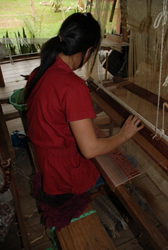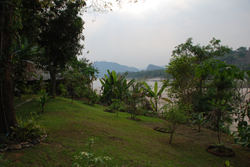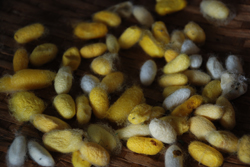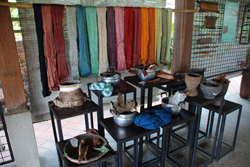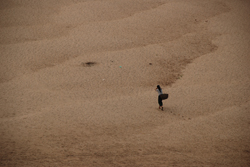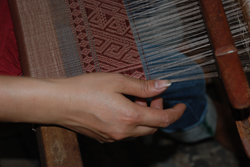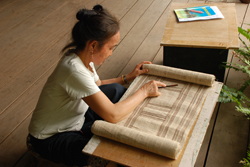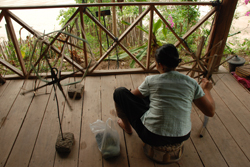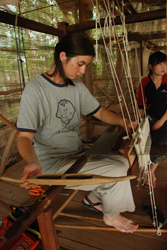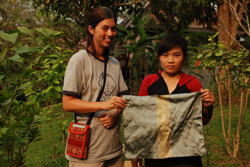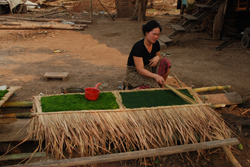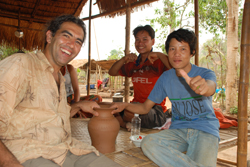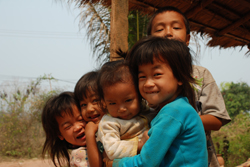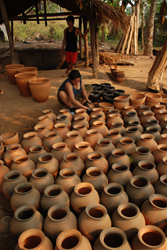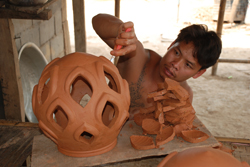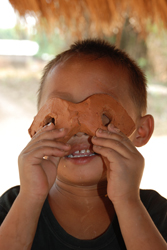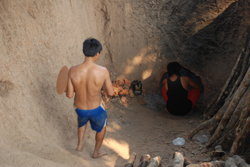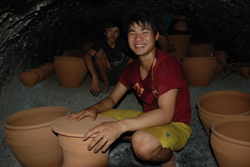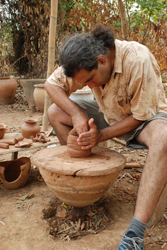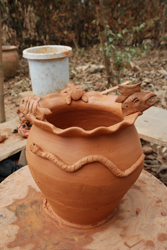Luang Prabang: Tamia Weaves a Placemat and Rowshan Makes a Big Pot
30 March, 2009, 11:56 am in "Laos"
Yesterday I took a weaving class at the Ock Pop Tok weaving center. We had visited both the Ock Pop Tok galleries in the center of town. At the first gallery, a woman walked by and raved about how she had just visited their weaving workshop south of town.
Ock Pop Tok is a Fair Trade textile organization. They create high quality designs which merge traditional and contemporary aesthetics. The silk pieces are beautiful. They dye silk with natural dyes and weave by hand on huge looms. They also have the “Village Weaving Project” so weavers in villages can sell their work (as well as other textile pieces). The workshop is in Luang Prabang but in a village absorbed by the city. The workshop center occupied a beautiful location on the river. The grounds were filled with flowers and trees, many signed and used for dye or food.
Young Rooster
Ock Pop Tok is a Fair Trade textile organization. They create high quality designs which merge traditional and contemporary aesthetics. The silk pieces are beautiful. They dye silk with natural dyes and weave by hand on huge looms. They also have the “Village Weaving Project” so weavers in villages can sell their work (as well as other textile pieces). The workshop is in Luang Prabang but in a village absorbed by the city. The workshop center occupied a beautiful location on the river. The grounds were filled with flowers and trees, many signed and used for dye or food.
The grounds had several buildings-- 3 were completely open with just roofs to protect them from the weather. They were the weaving, dying, and weaving class/batik buildings. One building was a traditional wood house. The open area underneath was a shop/gallery/cafe and exhibit space where there were samples of silk cocoons (and silkworm eggs with a couple tiny worms), weaving tools, and the natural plant parts used for dye. The cafe had a lovely view of the river and people walking across the sand bar.
The weavers are all women though the master weaver/dyer was male. Men also built the looms. The women learned to weave when they were children. They were paid by the piece and could make $80-100 per month. There were 2 main techniques for weaving-- one type wove just one color at a time. They used a template consisting of woven strings in a vertical warp. The woven strings when pulled up to the top of the template would change the strings of the loom making it easier to make the complex patterns like nagas or hooks. The second type of weaving involved adding colored patterns by hand. This was how I'd seen colors woven into other weavings around the world.
My translator/ instructor was a young man named Morn who was studying tourism management in the evenings and worked at the center during the day. He showed me the different plants in the garden. Then we took a quick tour of where the weavers were working. Then we went to the dye work area where the 2 masterweavers/ dyers were dying ikat pieces (tie-dyed), indigo, as well as solid colors. I chose 3 colors to prepare: orange which came from annatto seed which I ground a bit with a mortar and pestle before dumping it into boiling ash water (lye); lemongrass for yellow: one of the nicer smelling dyes just needed to be chopped up and thrown in boiling water; sappan tree wood: this wood usually produces pink but if a nail is boiled with it it makes purple. This dye is “fermented”. The mix is boiled and left in a vat. Dye is taken from it, mixed with boiled water and after the dying is finished it is returned to the vat to ferment some more. Indigo is also fermented.
Dying the silk, then rinsing it and hanging it in the sun to dry was a quick process. While the silk was drying I chose 2 colors from previously dyed silk to weave: light blue and gold.
These we took to the weaving area where Thor, one of the weavers who was my teacher for the day, showed me how to wind the thread onto bamboo spools. I thought the contraption-- 2 rotating bamboo frames, was a bit complex for just winding thread but I guess it also smooths the thread.
These we took to the weaving area where Thor, one of the weavers who was my teacher for the day, showed me how to wind the thread onto bamboo spools. I thought the contraption-- 2 rotating bamboo frames, was a bit complex for just winding thread but I guess it also smooths the thread.
Then Thor did some finishing adjustments to the loom and tightened the warp threads. Setting up the loom and the warp threads takes 3-7 days so I wasn't able to see how that is done. The warp threads which are thin strands of silk-- like spider webs, have to be threaded through a comb and wrapped by hand. But once the loom is set up it can weave 50-60 meters of fabric. Another time consuming part is the pattern parts are set into strings which are attached to heddle strings (sets of strings tied to the warp). A second heddle set are knotted to alternating strings which are operated by bamboo peddles to do the straight solid fabric weave. Thor was making sure the warp threads were tight by pulling the individual strands. Then she wove a rough edge of cotton string to hold the new weaving. She started operating the pedals with one foot: toe pushing one pedal, heel pushing the other and sent the shuttle flying between the warp threads. Then I tried. It was fairly straight forward though I had to go a lot slower than Thor. Thor and Morn hung out while I wove but jumped to action whenever there was a problem: a warp thread loose or the spool thread getting tangled.
After lunch, Thor added the shuttle of gold thread and showed me how to weave the pattern section. This was done by taking a string form the pattern heddle, moving it up and using it to separate the 2 heddle sets of strings. Then I pulled the front heddle strings up which lifted one set of warp strings which would create the pattern. A wooden piece, slid between the strings held the pattern which lasted for 2 passes of the gold shuttle (blue used the regular heddles operated by the peddles). Then the next string was moved up. This took some coordination but wasn't complicated. When I was finished with the piece, Thor cut the piece from the loom and set up the loom for the next piece. Then she pulled out the cotton string and twisted the end threads into a fringe against her leg. I left with my day's work, a pretty silk place mat and some skeins of dyed silk.
While I was weaving, Rowshan went to the pottery village and learned to make big pots. There, he also got to experience some other aspects of Lao life: seeing a woman drying river weed, a popular snack, drinking rice whiskey and hearing a young rooster learning to crow.
Young Rooster
He also got to see potters making clay lanterns which are popular fixtures at many of the hotels and restaurants. That day the villagers were loading the huge underground kiln. Rowshan was able to look inside.
Rowshan made a large pot and gave it characteristic Rowshan style decorations. Of course, since it was large, we didn't want to take it with us (or ship it) so Rowshan left it so his friends in the village would have something to remember him by.
Comments
- Comments
Powered by My Blog 1.69. Copyright 2003-2006 FuzzyMonkey.net.
Created by the scripting wizards at FuzzyMonkey.net..
(Code modified by Rowshan Dowlatabadi)
Created by the scripting wizards at FuzzyMonkey.net..
(Code modified by Rowshan Dowlatabadi)


